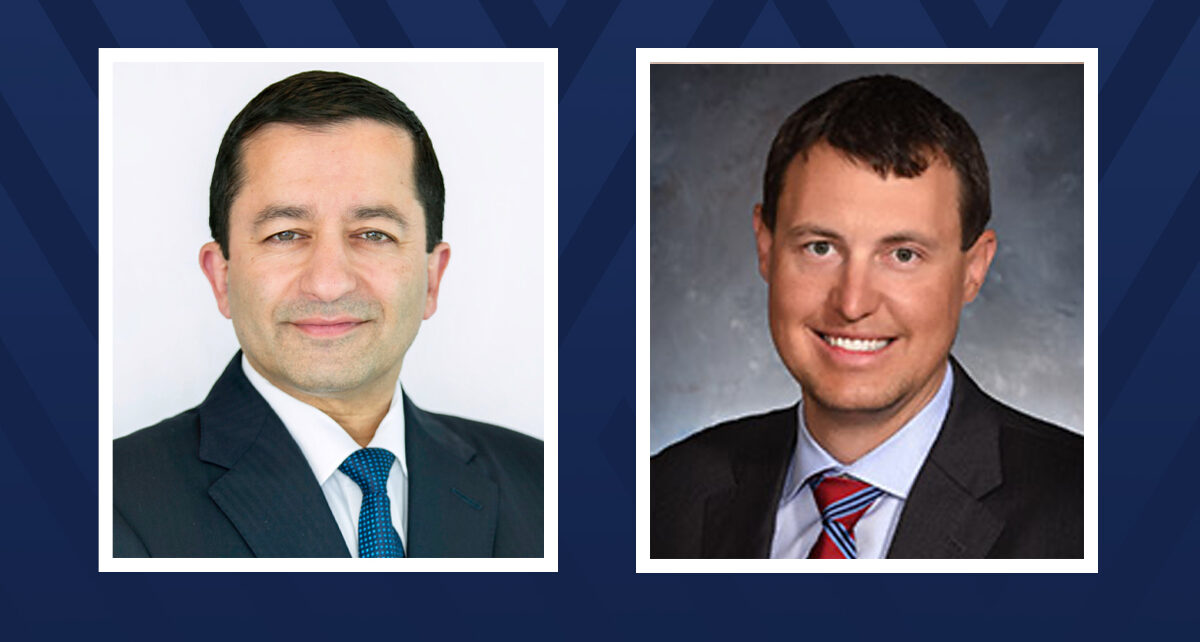Photo: Vinay Badhwar, M.D., professor and executive chair of the WVU Heart and Vascular Institute, and J. Hunter Mehaffey, M.D., assistant professor in the WVU Department of Cardiovascular and Thoracic Surgery
MORGANTOWN, W.Va. – A team of researchers led by Vinay Badhwar, M.D., professor and executive chair of the WVU Heart and Vascular Institute, and including J. Hunter Mehaffey, M.D., assistant professor in the WVU Department of Cardiovascular and Thoracic Surgery, and other cardiology and cardiac surgery leaders from across the United States, has provided important clarity on the safety and outcomes of an important surgical treatment of mitral valve regurgitation, or leakage, caused by mitral valve prolapse.
The mitral valve is the central valve of the heart, and it serves as a one-way gate that allows oxygenated blood from the lungs to be delivered into the left ventricle, or pumping chamber of the heart. Mitral valve prolapse is a common degenerative heart disease that may result in valve leakage when one or both of the two leaflets no longer touch each other. This abnormality, known as mitral regurgitation, results in blood moving backwards into the lungs, often accompanied by a murmur. Mitral regurgitation may lead to shortness of breath, irregular heartbeat, and, very rarely, sudden death.
“We have two main options to treat degenerative mitral valve regurgitation. The historical standard has been surgical repair, but we also have FDA-approved transcatheter or percutaneous devices for minimally invasive mitral valve repair that have encouraging early results, particularly in high-risk patients,” Dr. Badhwar said.
“National reference centers of excellence, like the WVU Heart and Vascular Institute, can provide all options to our patients, including robotic mitral valve repair. The recent challenge for providers has been when to recommend transcatheter or surgical robotic valve repair. While we know our results at WVU to be excellent, with essentially a 100 percent surgical repair rate, we have not known the outcomes and safety nationwide or how to precisely evaluate risks, until now.”
All invasive treatments carry with them some element of risk. In addition to the clinical judgement of medical providers, doctors use a risk calculator for mitral surgery to help estimate risks. The existing tool, based on national data from 10 years ago, has been good for estimating mitral surgery as a whole, but not for calculating the precise risk of repair of mitral prolapse.
As there is a potential to overestimate risks using existing tools, and there are currently two national clinical trials assessing the use of a percutaneous approach in lower risk individuals, Badhwar and his team of leaders recognized a gap in understanding of the actual safety and outcomes of repair of degenerative mitral valve disease.
“Much has changed in the specialty. Minimally invasive surgical techniques, such as robotics, as well as the national data itself have become much more precise,” Badhwar said. “To help inform providers and patients alike, we set out to provide updated information to allow for the most optimal evidence-based care for mitral valve disease to be delivered.”
The study, published simultaneously in the Journal of American College of Cardiology and the Annals of Thoracic Surgery, assessed contemporary information on 53,462 patients from the Society of Thoracic Surgeons Adult Cardiac Surgery Database who underwent mitral repair for degenerative regurgitation. The data revealed that the national rate of successful repair without replacement has reached 90 percent, and the rate of minimally invasive repairs, including robotic, has been increasing.
Most important, the study found that the risk of patient death up to 30 days after surgical repair was less than 1 percent in nearly all age groups. The data generated from this study was used to develop a new online national risk calculator for the repair of degenerative mitral regurgitation to help all medical providers make informed decisions on the care of their patients.
“We now have contemporary information that shows that surgical repair of degenerative mitral valve disease is very low risk and effective,” Badhwar said. “As we look to the future of non-surgical innovative therapies for mitral regurgitation, particularly for patients who are not of prohibitive risk, we must be very thoughtful to be sure we provide care that is at least equivalent, if not superior, to surgical repair. These new data will help inform patients and providers with augmented precision to select the most optimal therapy for their condition.”
The WVU Heart and Vascular Institute is a nationally recognized leader in the innovative treatment of mitral valve disease. For more information, visit WVUMedicine.org/Heart.
















